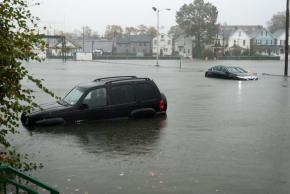The storm after the storm
rounds up news, observations and analysis about the disaster that followed in the wake of Hurricane Sandy as it struck the East Coast.
HURRICANE SANDY slammed into the Eastern seaboard, leaving behind a trail of devastation that will take weeks--and more--to repair. Some 50 people are believed dead, and the economic damage will run into the tens of billions of dollars.
Round-the-clock cable news shows reported countless examples of the storm's fury--the flooding of New York City's subway system, the flattening of the Jersey Shore, the millions of homes left without power.
But despite the nonstop media coverage of the storm, reporters in the mainstream media tended to let the most important stories float by--missing the larger dynamic of what was taking place in favor of the easy-to-capture images of automobiles submerged in Lower Manhattan.
It truly is a Frankenstorm
In contrast to the mainstream media that downplayed manmade aspects of this extreme weather event, author and environmental activist Bill McKibben continually explained why the storm was a particularly fierce consequence of human-induced climate change. Speaking on Democracy Now! McKibben explained:

It's really like something we haven't seen before. It's half again the size of Texas. It's coming across water that's near record warmth as it makes its way up the East Coast. Apparently we're seeing lower pressures north of Cape Hatteras than have been ever recorded before. The storm surge, which is going to be the very worst part of this storm, is being driven by that huge size and expanse of the storm...
It's Frankenstorm. Frankly, it's not only a catchy name; in many ways, it's the right name for it. This thing is stitched together from elements natural and unnatural, and it seems poised to cause real havoc. The governor of Connecticut said yesterday, "The last time we saw anything like this was never." And I think that's about right...
In the warmest year in U.S. history, when we've seen the warmest month, July, of any month in a year in U.S. history; in a year when we saw, essentially, summer sea ice in the Arctic just vanish before our eyes; what it means that we're now seeing storms of this unprecedented magnitude. If there was ever a wake-up call, this is it.
In August of last year, Tropical Storm Irene sliced through the East Coast, causing 50 deaths, leaving 1 million people without power and wreaking destruction to the tune of $15 billion. At the time, we were told it was "the storm of the century." Brace yourself for next year's "storm of the century."
A crane dangles over New York
In Manhattan, the arm of a crane atop a 90-story luxury high rise on 57th Street snapped in Monday's high winds. With tons of heavy machinery threatening to plunge 1,000 feet to the street below, police cleared the area while they figured out what to do next.
Largely escaping commentary was the fact that One57, as the building is known, is a future playground for some of the world's most obscenely wealthy people. Apartments on the top floor of the building are being sold for an eye-popping $90 million each. No doubt the billionaires anxious to take possession of their new luxury condos in the sky will be disappointed that the storm will delay their occupancy.
Meanwhile, the city of New York is spending $1.5 billion over 15 years to upgrade its storm water management system, and it recently announced another $1 billion in "unglamorous" infrastructure work. But this is a fraction of what's needed to address the growing frequency of "100-year" storms.
Already, according to the HuffingtonPost.com:
More than 27 billion gallons of untreated sewage and polluted wastewater spill into New York Harbor every year, often after as little as one-tenth of an inch of rain overloads the city's antiquated plumbing system that combines waste from homes and businesses with normal stormwater. What's more, the public is often left unaware of these sewer overflows, and sight or smell is not always enough to decipher water quality.
What's remarkable is that the billionaires lining up to purchase condos in One57--or billionaire Mayor Michael Bloomberg himself--could finance these projects out of their own pockets without even noticing. Instead, the billionaires build giant condos in the sky for themselves while the rest of us contend with ailing schools, creaking infrastructure, tax increases and budget cuts--because "the money has to come from somewhere."
Austerity by storm
Mayor Bloomberg ordered all city workers--including non-essential personnel--to come to work on Monday and Tuesday, even though the public transit system and the majority of bridges and tunnels were shut down.
And if you didn't show up, Bloomberg threatened to dock your pay.
One city hospital worker who is a regular reader of SocialistWorker.org had this to say:
Bloomberg shut down all public transportation and most bridges and tunnels and still required city workers to show up regardless of whether their job was really that important. But Bloomberg wasn't exactly offering up his crew of chauffeurs to get us to work...or Gracie Mansion to live in.
There were supposedly some pickup spots for HHC [public hospital] employees in each borough to bring us in to work on Tuesday, but I'm not sure if they worked--and no one I know used them. Basically, those of us who could showed up yesterday and today, but I'm not sure what's going to happen if public transportation stays shut down for more than a few days.
Also, our city hospital--Metropolitan--is relying on a generator for electricity since it's near the East River and the basement was flooded. My coworker who's been staying at the hospital since the early hours of Monday morning said they shut down the elevators of our 15-floor building because of the flooding. And word is that we are receiving Bellevue patients because their backup generator failed.
Blair, another reader from New York, added:
My sister-in-law works for an agency employed by the city and is in the city government employees union. She--and I believe all Bloomberg staff--was told not to drive to work, and they obviously couldn't take MTA. But they were expected at work. If they didn't show up, it would count against their comp days for the year. They said, however, that it would be okay if they came in late on Monday--how generous! They said that making people pay for their days off would save the city $30 million to help cover storm costs.
Pay no attention to the nukes behind the curtain
The path of Hurricane Sandy took it directly over at least 16 different nuclear facilities and six oil refineries. One of the nukes--the Oyster Creek facility on the Jersey coast--declared an emergency "alert" because rising sea water threatened to submerge the pumps used to circulate cooling water.
Oyster Creek is the oldest nuclear facility in the U.S. and is based on the same design--except more antiquated--as Fukushima plant in Japan that spewed radioactive waste into the atmosphere and the Pacific after last year's tsunami interrupted the plant's power supply and then submerged its backup generators.
Thankfully, Forbes.com commentator James Conca quickly penned a note to rebut "alarmists [who] may take it as reason to shut all nuclear power in America." According to Conca:
There's no reason to worry about the safety of nuclear power in the face of natural disasters like this. Just like the flooding last year, just like the earthquakes this year, it would be surprising if this storm causes real problems such as release of radioactivity. Oyster Creek was already in a previously scheduled shutdown before the storm hit.
Conca acknowledges that the storm may be "a threat to many other systems, like subways, natural gas plants and pipelines, dams, hospitals, the electric grid." All those, but not nukes, he says. "Although those with real ideological issues against nuclear energy may have gotten a bit excited," he insisted, "there is nothing so far to worry about with respect to the nuclear plants."
Conca then attacks Arnie Gunderson, a former nuclear industry executive-turned-critic. Why? Because he "doesn't really know the nuclear technical stuff, but only cares about politics."
You be the judge of what Gunderson knows. On Democracy Now! Gunderson explained that plants like Oyster Creek were built before the climate changes we're now experiencing were a scenario to prepare for:
We call this a "design-bases event." No one ever thought that Oyster Creek would see seven feet of flooding to the point where their service order pumps were in jeopardy. This issue of global warming is important, because we've got conditions now where what we thought was the worst Mother Nature can throw at us, in fact, she had.
The Oyster Creek event was like a one-in-a-thousand-year kind of a flood, and it happened. So if these design-bases events are occurring, we need to re-evaluate these older plants and say, "Oh, my god. We could have a more significant design-basis event than we ever imagined."
Ideology versus Mother Nature? No contest
Republican president candidate Mitt Romney might want to dust off his Etch-a-Sketch again.
During a Republican primary debate last year, he said he would eliminate federal disaster services like the Federal Emergency Management Agency (FEMA). Instead, Romney said, the 50 states should be responsible for disaster relief. "[S]end it back to the states," said Romney to the surprise of debate moderator John King. "And if you can go even further, and send it back to the private sector--that's even better."
But after Hurricane Sandy made landfall yesterday, Romney changed his tune. According to a spokesperson:
Gov. Romney believes that states should be in charge of emergency management in responding to storms and other natural disasters in their jurisdictions. As the first responders, states are in the best position to aid affected individuals and communities, and to direct resources and assistance to where they are needed most. This includes help from the federal government and FEMA.
In the era of neoliberalism, politicians from both parties promote "free-market" solutions to every social need, insisting that cutting taxes and cutting government spending can only make the world a better place--until they don't. Disaster relief and bank bailouts are two obvious examples.
No private-sector company can or will decide to undertake multibillion-dollar infrastructure projects, even if those projects are essential to maintaining safe drinking water or treating raw sewage that would otherwise run in the streets. Only governments can marshal the resources necessary for such projects.
So while politicians like to talk about cutting taxes and spending, what they really mean is cutting taxes for corporations and cutting government spending on social programs. But whenever there's a highway that needs to be built or a financial institution to be bailed out, they're first in line to explain why such spending is essential. Call it the Leave No Bank Behind principle.
The world's governments are also the only entities in a position to address climate change--before the oceans inundate the coasts and our already precarious place on this earth becomes even more so. But since governments are first and foremost the caretakers of global capitalism, it will be up to the rest of us to mobilize in sufficient numbers to demand a different agenda.


